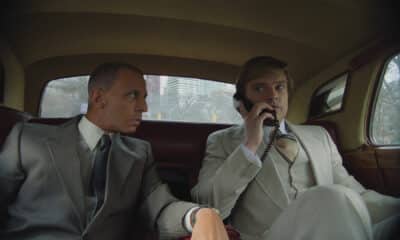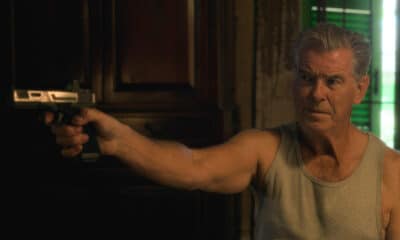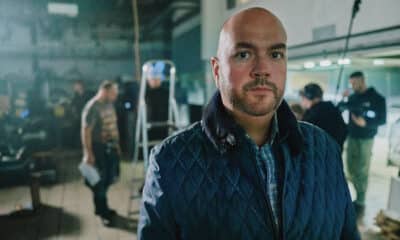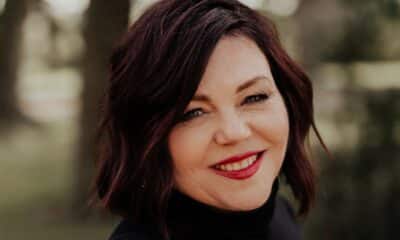Luca Severi is the talented young filmmaker behind new documentary feature, That Click, a portrait of legendary Hollywood photographer Douglas Kirkland. From Marilyn Monroe to Jack Nicholson and Leonardo DiCaprio, Kirkland has photographed the Hollywood elite for more than 60 years. This is his incredible untold story.

A man at the cutting edge of fashion, photojournalism and portraiture, photographer to the stars Douglas Kirkland has, with his camera, portrayed over sixty years of pop culture. Famed for his legendary shoots with Hollywood favourites including Marilyn Monroe, Elizabeth Taylor, Angelina Jolie and the stars of over 150 motion pictures – The Sound of Music, Moulin Rouge, Titanic and The Great Gatsby to name a few – Kirkland’s unique style and approach have resulted in hundreds of beautiful, immortal images that still influence the world today, decades after that first fateful click of the camera.
That Click takes a closer look into the astonishing career of one the most important photographers of the last century, from his very first assignments at Look magazine in the 50’s to Vanity Fair in the present, featuring interviews with Sharon Stone, Nicole Kidman, Michelle Williams, Baz Luhrmann, Andy Garcia and many more.

Luca Severi tells us how the film was made.
How did your feature documentary That Click come about, and how did you become involved?
The director of photography Gianfilippo De Rossi is a good friend and part of my production company. A few years ago, he was an emerging photographer and he worked a little for Douglas Kirkland. He told me about this amazing photographer I should meet, and that Douglas and his wife Francoise hosted a lot of dinners and social gatherings for friends in their house. One time, during one of those gatherings, he called me since I was living nearby at the time, and he said I should come by as it was a very open environment.
When I arrived and saw Douglas’ incredible pictures on the wall, it seemed so obvious that there was a story behind each one. I got along very well with Douglas and Francoise right away and, after a few months of getting to know them and hanging out, I thought we could do a documentary, with my small production company. Initially they seemed a little sceptical, maybe they weren’t sure if we could do it, so it took a bit of convincing, but once they knew he were serious, they allowed us to start.
How long were you shooting for?
The whole process took around two years. It was partly affected by having so many celebrity interviews. They were all really happy and open to being involved, but their schedules are often very busy. In some cases, we were scheduling appointments up to 18 months in advance! Douglas was also travelling a lot for exhibitions, collecting awards and things like that, so we travelled with him at times, or caught him when he got back to Los Angeles.
Also, being an independent production company with a plan to finance the film ourselves, we had to work on other projects at the same time to keep the documentary going.
Was it hard to arrange so many of those great interviews? You have a lot of huge stars in there.
The hardest thing was the scheduling. Douglas is so loved by everyone, especially those who’ve been photographed by him. Remember, we’re talking about people who are photographed all the time. Yet with him and his work, there’s a special chemistry. Again, the guests were very open and wanted to be involved, but organising it was the hard part.
What was the most interesting thing you learned about Douglas while making it?
I’m not an expert on photography from a technical point of view. I didn’t want our film to be a technical explanation of photography, I wanted to show the impact on pop culture. Douglas’ pictures are part of our cultural backdrop. Still, at the same time, I wanted to know why he’s a great photographer, because I didn’t really understand why. So, I asked this question to some very famous photographers. What’s interesting is that they didn’t talk about specific equipment, lenses or lighting, they talked about the relationship he builds with his subjects. That was really interesting, and I didn’t know that was possible at all, I thought it was all very technical. I believe this is what makes his work so impressive.
How was the editing process, and did you have lot of footage to work with?
It took around a year for post-production. I had a pretty precise idea of what I wanted from the footage, but we had a lot of surprises too. Douglas has a huge amount in his own archive, early family footage, pictures and so on, and he’s kept pretty much everything. There’s really interesting and surprising stuff, like seeing him with his family in a different environment than when he’s working with celebrities, so I wanted to show that alongside his professional work.
What do you hope audiences can take away from That Click?
There’s two layers. First, I think passion should be a priority in all of our lives. Whatever you do, whether it’s passion for a job, an art, hobby, or for another person. It’s about what this can do for you and how enriching it can be. I think Douglas’ story explains this very well.
The second point is about how much showbusiness impacts all of us, and points to a responsibility with content creators. The impact an image or a film can have is much stronger and longer lasting than many of us realise. And if you make a film, try to make it a good one, because it will survive you. People will look at it after you’re gone, and hopefully their reaction is positive!
What’s next for you?
My company alternates between documentaries and narrative features which we like doing. Next, we’re working on a feature film, Bad Tales, written by the D’Innocenzo Brothers who won the Silver Bear for Best Screenplay at the Berlin Film Festival this year. They’re our friends and part of our group of young, emerging Italian filmmakers who started together, and we all support each other. We’re also developing other scripts and projects.
One thing I saw first-hand making That Click was the love Douglas has for other people. In areas like showbusiness, celebrity culture, even journalism, we’re used to seeing the competitive side. Douglas showed us that the more you collaborate and strive to be inclusive; the happier and more enjoyable things can be. This is something that’s inspired me in my own work.
Kaleidoscope Entertainment presents That Click out now in selected cinemas.

Latest Posts
-


Film News
/ 17 hours agoSTUDIOCANAL picks up Ali Abassi’s ‘The Apprentice’ for the UK and Ireland
It has just been announced that STUDIOCANAL has picked up the Cannes-debuting The Apprentice....
By Paul Heath -


Film Trailers
/ 19 hours agoTrailer for thriller ‘It’s Not Over’ with Christopher Lambert
Christopher Lambert is back in the new trailer for the upcoming thriller It’s Not...
By Paul Heath -


Film News
/ 19 hours ago‘Happy Gilmore 2’ is happening at Netflix
The news has been confirmed. A sequel to the Adam Sandler comedy Happy Gilmore...
By Paul Heath -


Film News
/ 19 hours agoPierce Brosnan to lead the cast of horror-thriller ‘Wolfland’
Some news coming out of Cannes is that Pierce Brosnan will lead a horror-thriller...
By Paul Heath















